Siding a house costs $10,693 on average, with most homeowners spending between $5,630 and $17,388 or between $2.33 and $15.33 per square foot. Low-end siding projects average around $2,300, while large-scale siding projects can cost as much as $90,000 or more. These costs include the materials, labor, and site cleanup.
Adding siding to your home — or replacing the existing siding with new siding — can increase your home’s curb appeal and value. Wood, vinyl, metal — there are plenty of siding materials, colors, and styles to choose from.
The overall cost of siding your home will depend on many factors, including the siding’s material and how much you need. Often, siding is just one piece of a bigger home improvement project, which might include replacing old windows or installing new gutters. Our pricing guide includes those additional costs, too.
How Much Does Siding Cost?
- Average National Cost: $10,693
- Typical Range: $5,630 to $17,388
- Low End: $2,300
- High End: $90,000 or more
The costs listed above are the national averages for siding a typical 1,500- to 2,500-square-foot home. The average homeowner will spend $10,693 for house siding, with most homeowners spending between $5,630 and $17,388 or between $2.33 and $15.33 per square foot.
Prices will vary depending on the siding’s quality and material type. Some siding projects can cost as low as $2,300 or as much as $90,000.
For the siding materials alone, homeowners spend an average of $1 to $10.66 per square foot, though some siding materials can cost much more.
Labor rates usually range between $0.92 to $5.67 per square foot, yet this can also increase due to the siding’s material. Stone, for instance, can raise labor costs to as much as $14.15 per square foot.
Cost Estimator by Siding Material
Your siding material type will have a significant effect on costs. Wood siding can cost as little as $2.25 per square foot to install, while stone can cost as much as $38.37 per square foot.
Different types of siding each have their own pros and cons, and some require more maintenance than others. If you have a large house and want to side it with stone or brick, have that checkbook ready.
| SIDING MATERIAL | AVERAGE COST * per square foot, installed |
| Wood | $2.25 to $15.25 |
| Vinyl | $2.50 to $10.75 |
| Aluminum | $3 to $7.25 |
| Engineered Wood | $3.40 to $9.25 |
| Steel | $4.25 to $8.75 |
| Fiber Cement | $4.50 to $11.25 |
| Stucco | $5.50 to $7.50 |
| Brick Veneer | $8 to $13 |
| Brick | $11 to $27 |
| Stone | $21.50 to $38.75 |
Wood
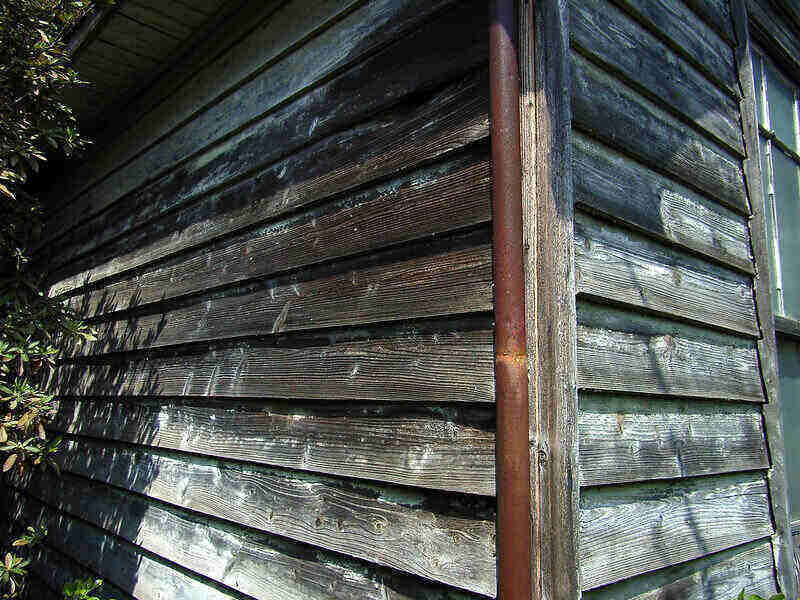
Wood siding is popular for its natural look and versatility. You can color it with paint or wood stain, and it comes in several different styles, such as shingles, clapboards, and shakes.
There are many different types of wood siding, including pine, cedar, or spruce. On average, wood siding costs between $2.25 and $15.25 per square foot.
Pros:
✓ There are many wood types to choose from, all with varying degrees of durability and quality.
✓ Wood siding comes in different styles, such as clapboards or shakes
✓ Installation and repairs are easy
✓ Natural, warm appearance
✓ Wood siding can be stained or painted
✓ Wood siding lasts between 20 and 40 years
Cons:
✗ Wood siding requires regular sealing
✗ Wood is susceptible to rot, mold, and insects
✗ Wood is not as insulating as other siding materials
✗ Wood requires regular upkeep via painting or staining
Maintenance:
Wood siding requires high maintenance. For example, you will need to protect wood from moisture damage, as this can lead to rot or termite infestations. To help prevent moisture damage, you will have to paint or stain wood siding every 3 to 5 years and apply a clear sealer every two years.
Vinyl
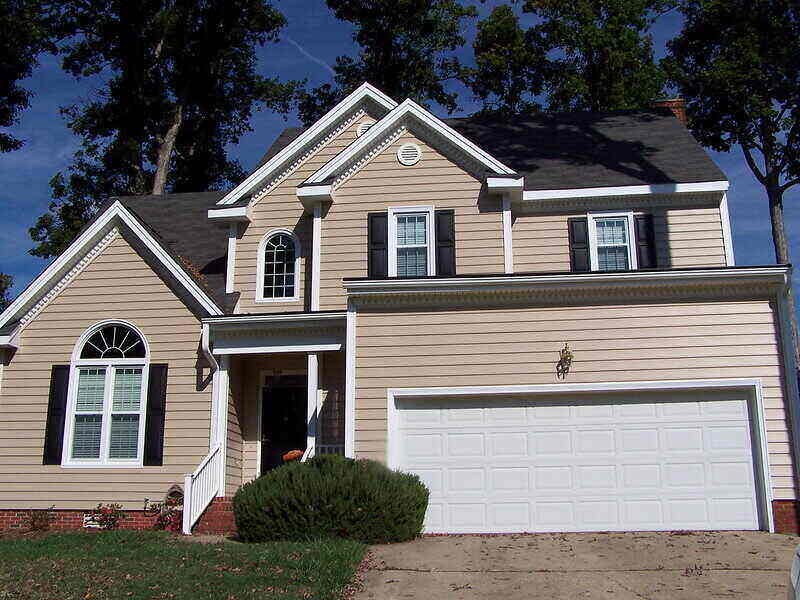
Vinyl siding has a relatively low cost and is easy to maintain. Most homeowners spend between $2.50 to $10.75 per square foot for vinyl siding installation.
Vinyl siding costs will vary depending on the vinyl’s style and thickness. Vinyl is not the most durable material when it comes to extreme weather conditions.
Pros:
✓ Vinyl siding is resistant to insects and rot
✓ Vinyl retains its color well –– it doesn’t need repainting or staining
✓ Vinyl can be made to look like other siding materials
✓ Low maintenance
✓ Vinyl siding lasts between 20 and 40 years
Cons:
✗ Extreme weather conditions can cause the vinyl to bend and crack.
✗ Vinyl siding usually won’t increase home value
✗ Vinyl is not waterproof, which means it’s still susceptible to some water damage, leading to warping.
✗ Vinyl is made of plastic, making it less eco-friendly than a material like wood.
Maintenance:
Vinyl siding is low maintenance. When it has stains or dirt that needs cleaning, wash it off using a soft cloth or soft-bristled brush. Then, wash it down with a garden hose.
Aluminum
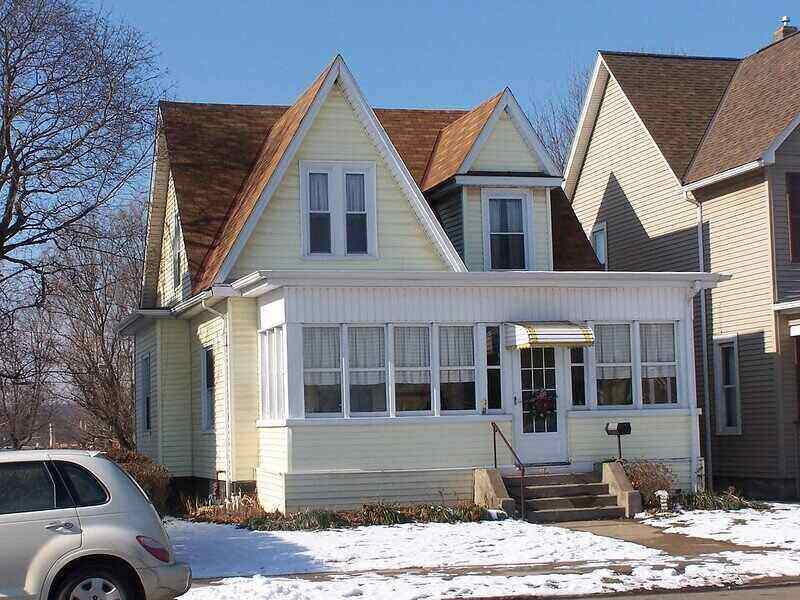
Aluminum siding is a popular alternative to wood and averages between $3 and $7.25 per square foot. It’s low maintenance, resistant to insects and mold, comes in various colors, and can even be painted. Aluminum provides excellent insulation, helping you to save on cooling and heating costs.
Pros:
✓ A popular alternative to wood
✓ Waterproof –– no mildew or mold
✓ Its lightweight design makes for easy installation
✓ Fireproof
✓ Resistant to insects, rot, and rust
✓ Recyclable
✓ Low maintenance
✓ It comes in a variety of colors
✓ Can be painted
✓ Aluminum siding lasts between 40 and 50 years
Cons:
✗ Aluminum siding makes a noisy dinging sound when it expands in hot temperatures or when rattled by the wind
✗ Aluminum dents easily
✗ Colors fade over time
✗ It can be difficult to color-match replacement aluminum siding with existing siding that has faded in color
✗ Due to oxidation, aluminum forms a chalky buildup on its surface.
Maintenance:
Similar to vinyl siding, aluminum is easy to clean — just wash it down with your garden hose about once a year.
For persistent stains, a pressure washer can help. Always use the right PSI levels on your siding product.
Engineered Wood
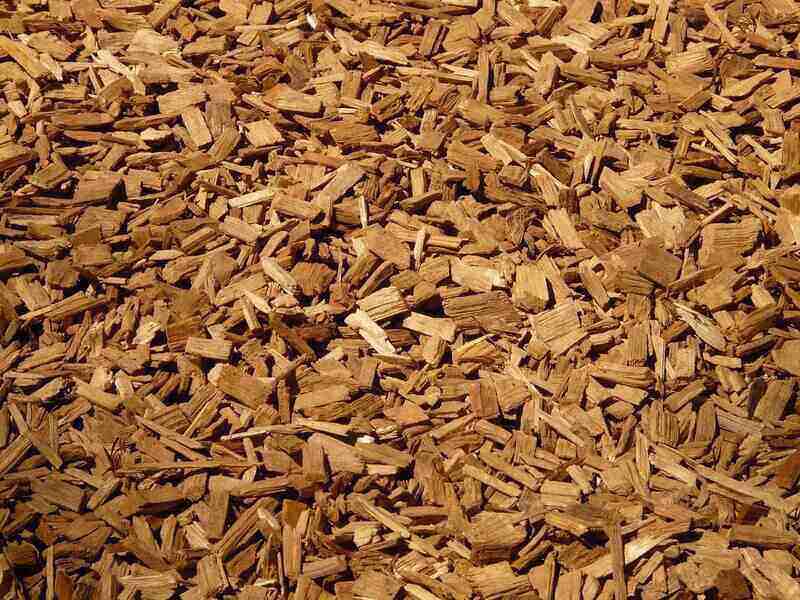
Engineered wood is a siding material made of wood waste products, such as sawdust and wood flakes, held together by a bonding agent. The bonding agent is typically glue, wax, or resin.
Engineered wood typically costs between $3.40 and $9.25 per square foot. It’s more durable, lightweight, and easier to maintain than traditional wood siding. Some engineered wood types contain water-resistant waxes, insecticides, and fungicides to help limit decay and insects.
Pros:
✓ Engineered wood siding is more durable, lightweight, and easier to maintain than traditional wood siding
✓ Mimics the look of natural wood
✓ Comes in a variety of colors and textures
✓ Most engineered wood types are resistant to decay and insects
✓ Easier to install than traditional wood
✓ It holds its color longer than traditional wood
✓ It is easy to repair
✓ It lasts up to 30 years
Cons:
✗ Colors can fade over time.
✗ Susceptible to cracking
✗ Despite being more water-resistant than natural wood, engineered wood is still prone to moisture damage. It’s not an ideal waterproof solution.
Maintenance:
Engineered wood is much easier to maintain than traditional wood. It doesn’t need to be repainted as much, and it’s more resistant to decay and insects.
When mildew appears, wash it off with water and white vinegar using a soft cloth.
Steel
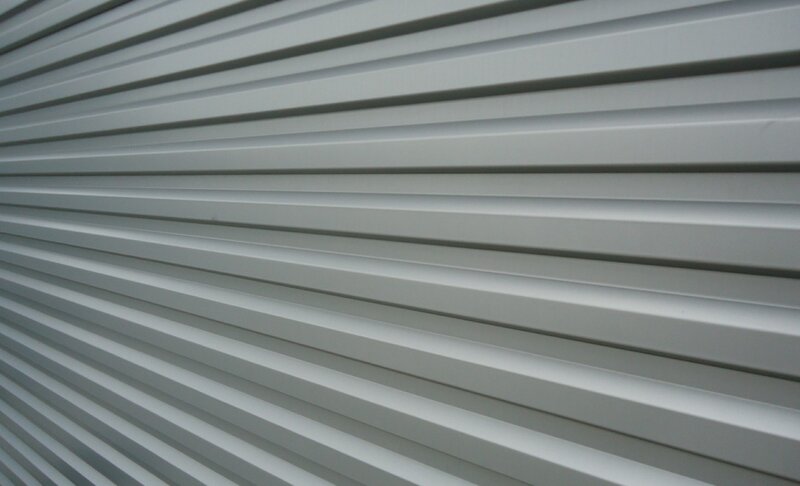
Steel siding prices range between $4.25 to $8.75 per square foot. Steel siding is more durable than aluminum and is less likely to dent. Steel siding comes in many styles and finishes.
The downside to steel is that it will rust over time. However, some homeowners may find the rusty look desirable, especially with a siding like Corten steel. Corten steel is a durable material made with alloys that cause the steel to develop a protective rust coating. The coating often gives the metal siding an attractive, rugged look.
Pros:
✓ Steel is more durable than aluminum and less likely to dent
✓ Comes in many styles and finishes
✓ Very resistant to fading
✓ Despite steel’s vulnerability to rust, Corten steel offers an appealing rust style
✓ Recyclable
✓ Fire-resistant
✓ It lasts up to 50 years
Cons:
✗ Steel is prone to rust
✗ More expensive than aluminum
✗ Steel is heavier than aluminum and takes longer to install
✗ Though more durable than aluminum, steel is still susceptible to dents and scratches
Maintenance:
Keep your steel siding clean with a washcloth, cleaning solution, and garden hose. If the dirt is stubborn, spray off the grime with a pressure washer.
Fiber Cement
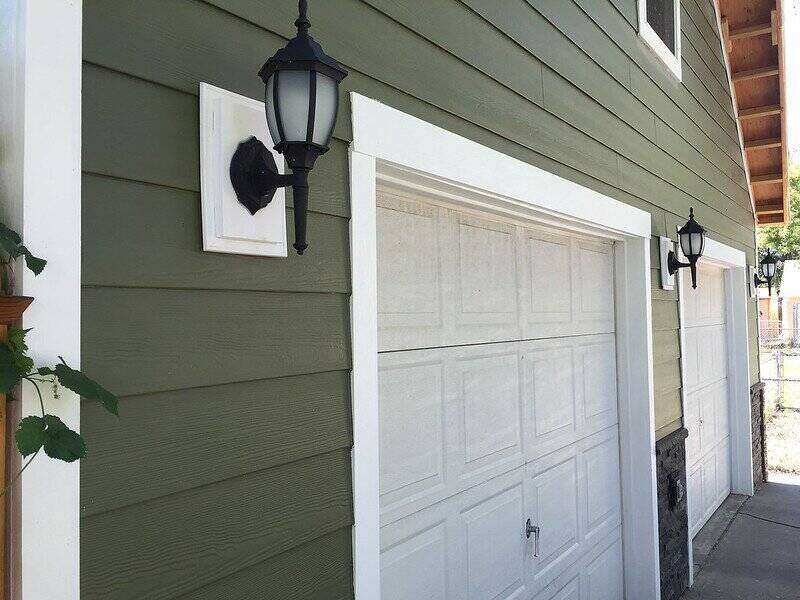
Fiber cement is a combination of sand, clay, cement, and cellulose fibers. Fiber cement siding comes in various colors, styles, and textures and can be made to look like many other siding materials. It can even be designed to mimic the appearance of natural wood grain.
Homeowners typically spend between $4.50 and $11.25 per square foot for fiber cement siding. Though expensive, fiber cement has many advantages.
Pros:
✓ Cracks are easy to patch
✓ Fireproof
✓ Resistant to rot, weather, and insects
✓ Features many different colors, styles, and textures
✓ Made to look like various siding materials, including wood and stone
✓ It does not need repainting as often as wood
✓ It can last 50 years or more
Cons:
✗ May crack
✗ Fiber cement is very heavy, making for an expensive installation process
✗ Requires special equipment for installation –– not an ideal DIY project
✗ May lead to moisture problems if the damage is left unrepaired
✗ Will need repainting
Maintenance:
Inspect your fiber cement for cracks, as damages in the siding can lead to moisture problems. Fiber cement siding will also need repainting every 10 to 15 years.
If cracks appear in the caulk, new caulk will need to be applied. Caulk is typically applied to the joints between the siding and other parts of the home.
Stucco
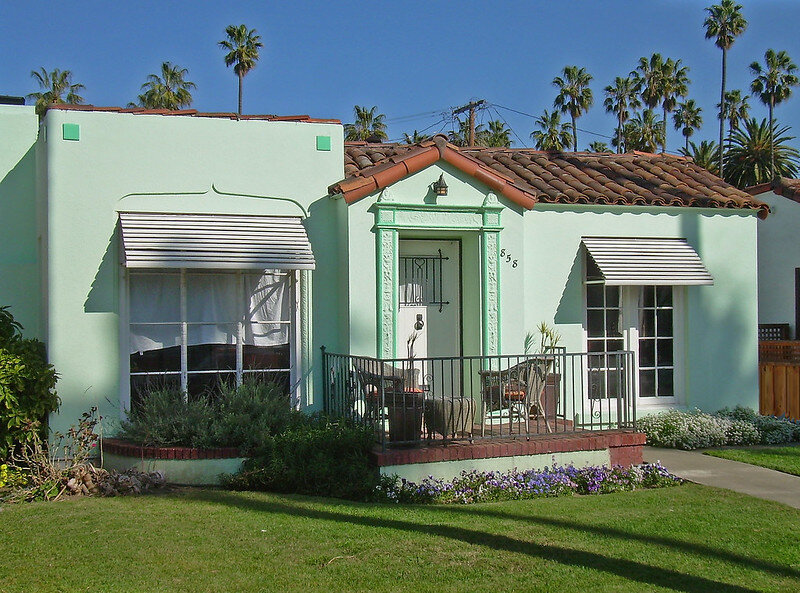
Stucco costs most homeowners between $5.50 and $7.50 per square foot. Stucco is a plaster-like material made of sand, water, and Portland cement. Unlike wooden or vinyl panels, stucco creates a seamless exterior around the home.
Pros:
✓ Resistant to fire and insects.
✓ It retains its color well
✓ It comes in beautiful earthy tones
✓ Blocks out sound from the outdoors
✓ Can be painted
✓ It is applied by hand so that it can form many textures
✓ Stucco lasts 50 to 80 years
Cons:
✗ Cracks easily
✗ Application is labor-intensive
✗ Cracks and holes can lead to moisture problems
Maintenance:
Stucco is a porous material, which means that it can absorb moisture and stains. To protect your siding from moisture damage, apply a sealer every five years and repair cracks in the stucco siding as soon as they appear.
Use a nylon brush and washcloth to remove any dirt or grime.
Brick Veneer
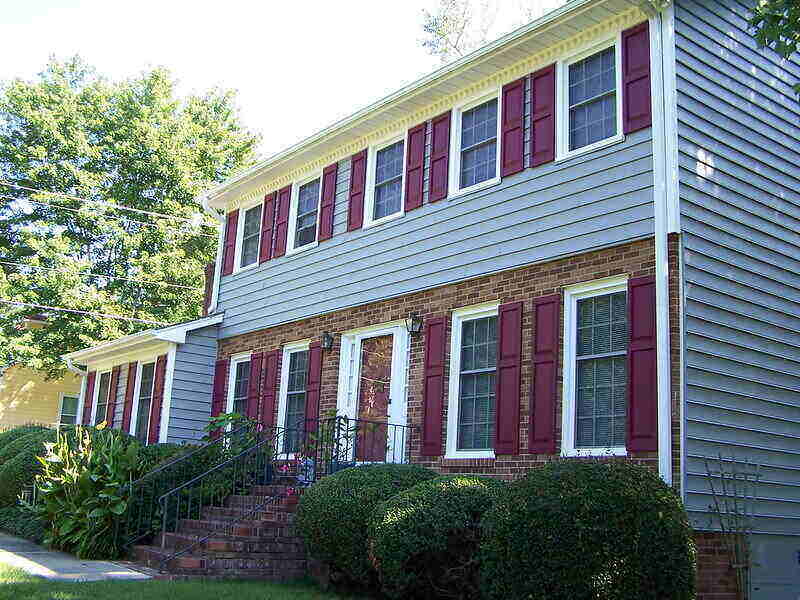
Brick veneer siding is made of real clay brick. But instead of standard-sized bricks, brick veneer is made of thin bricks that are lightweight and more affordable. Unlike traditional brick, which is installed during the home’s construction, brick veneer can be installed as a siding at any point.
Brick veneer is long-lasting, fireproof, insect-resistant, and rot-resistant. On average, homeowners spend between $8 and $13 per square foot for brick veneer siding.
Pros:
✓ More affordable than siding the home with standard bricks
✓ Brick veneer gives your home a timeless, classic look
✓ It weighs less than traditional bricks, making for an easier installation
✓ Fireproof
✓ Rot and insect resistant
✓ A good alternative to building a masonry home with a brick-by-brick structure
✓ Durable
✓ Brick veneer lasts 40 to 50 years
Cons:
✗ Moisture problems can occur if water gets between the veneer and your home’s exterior wall.
✗ Brick veneer is not ideal for areas where earthquakes are common. High vibrations can damage brick veneer siding.
✗ Not as durable as solid brick, which can last for more than 100 years.
Maintenance:
Maintaining brick veneer won’t give you much of a headache. Check your brick veneer for any cracks or damages and have them repaired.
Keep the siding clean using a mild cleaning solution and a garden hose. Avoid using a pressure washer, as it can ruin the appearance of your brick veneer.
Brick
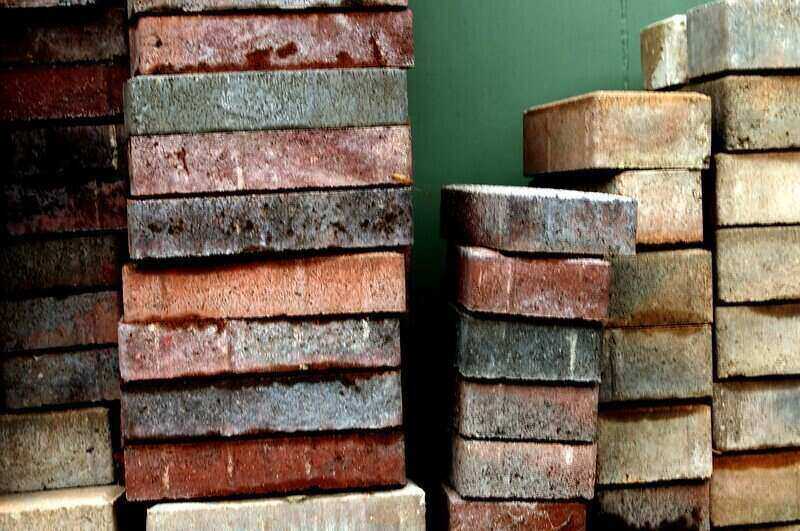
For houses with traditional brick siding, the brick is installed during the home’s construction. The brick makes up the structure of the house, giving it a classically beautiful look. In most cases, you’ll need to hire a mason to install the siding brick by brick.
Solid brick siding is much more expensive than brick veneer, costing most homeowners between $11 to $27 per square foot.
Pros:
✓ More durable than brick veneer
✓ A traditionally beautiful look for your home
✓ Fireproof
✓ Insect and rot-resistant
✓ Brick makes up the home’s structure
✓ Brick can last for more than 100 years
Cons:
✗ Expensive
✗ Heavier than brick veneer and takes longer to install
✗ Must be installed during the home’s construction
Maintenance:
To keep your brick home in like-new condition, replace damaged bricks and keep an eye out for moss and mildew.
When cleaning brick, always use a mild detergent, a soft-bristled brush, and a garden hose. Avoid scrubbing brick with metal bristles or using a pressure washer, as these can alter brick’s appearance.
Stone
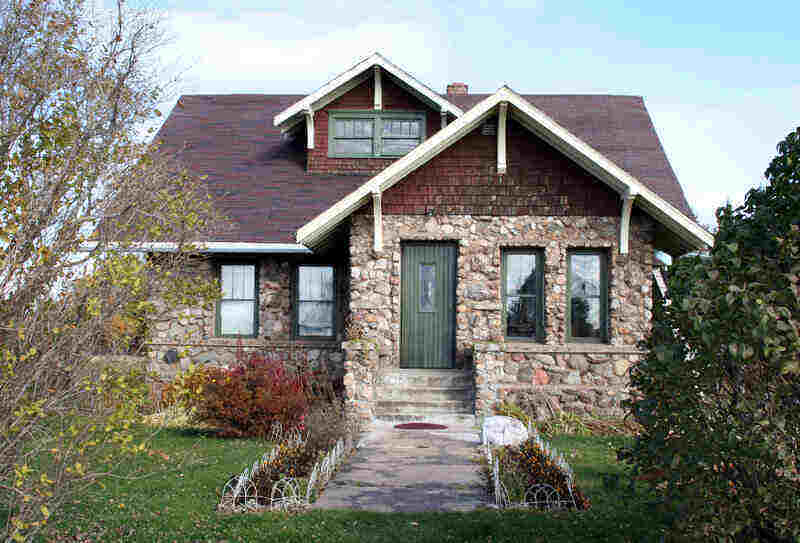
Natural stone is typically the most expensive siding material, costing most homeowners between $21.50 and $38.75 per square foot.
Stone siding features stones of various colors, textures, shapes, and types, such as granite, marble, slate, and limestone. Solid stone can be installed using naturally shaped rocks or rocks that have been cut to form blocks.
Pros:
✓ Timeless, luxurious look
✓ Resistant to fire, rot, and insects
✓ Colors won’t fade
✓ Durable
✓ It lasts for 100 years or more
Cons:
✗ Expensive
✗ Labor Intensive
Maintenance:
Natural stone siding is easy to maintain, and it’s resistant to rot, decay, and insects. To keep your brick clean, wash it down with a hose and washcloth about twice a year.
Other Factors That Affect Cost
While your choice of siding has a significant effect on total spending, there are a few other factors to consider. Siding a home is a big project, which means there are many costly factors at play, such as:
- Labor: Some siding materials are more complicated to install than others, leading to higher labor costs.
- Your Home’s Size: The larger your home, the more you can expect to pay for materials and labor.
- Architectural Features: If your home has multiple corners or additional features that make installation more complex, you may need to pay more for labor.
- Quality: Higher quality sidings are going to pull more from your wallet.
- Removal: Need to remove existing siding before installing new siding? We’ve got that added cost covered in this pricing guide.
- Residing: Re-siding involves removing old siding to make room for the new.
- Repairs: Sometimes, all your siding needs is a minor fix. No need to pay for an entire siding replacement.
- Insulated Siding: Considering insulated siding? We’ll show you the best siding option.
Labor
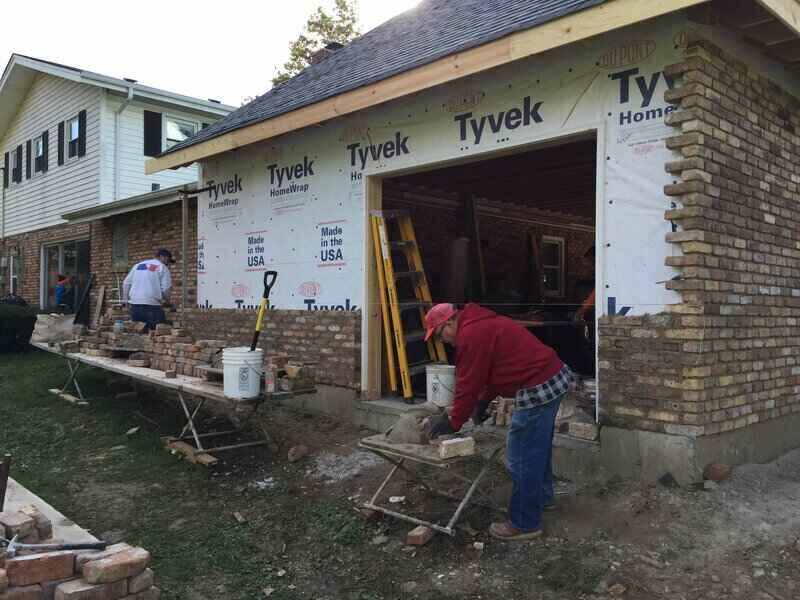
When you find your stucco siding labor bill is higher than your neighbor’s wood siding labor bill, don’t be surprised by the difference.
Labor rates for siding installation won’t be the same across the board. Some siding materials are more complicated to install than others. Heavy materials like stone or steel make the installation process more challenging, leading to higher labor rates per square foot.
Materials can present installation challenges besides weight. For instance, fiber cement requires special tools to cut and apply the material. And stucco must be applied by hand trowels.
| SIDING MATERIAL | AVERAGE LABOR COST * per square foot |
| Wood | $1 to $3.14 |
| Vinyl | $1.06 to $2.50 |
| Aluminum | $1.47 to $2.57 |
| Steel | $1.47 to $2.57 |
| Fiber Cement | $1.70 to $2.47 |
| Stucco | $2.17 to $7.41 |
| Stone | $6.84 to $14.15 |
Size of home
Your home’s size will determine how much siding you need. The bigger your home, the more you can expect to pay for labor and material costs.
Below are the average price ranges to side a home between 1,500 to 2,500 square feet in size. Depending on your home’s size, your total spending might fall below or above these average costs.
| SIDING MATERIAL | AVERAGE COST TO INSTALL |
| Wood | $4,950 to $26,775 |
| Vinyl | $4,999 to $16,836 |
| Engineered Wood | $5,733 to $15,700 |
| Stucco | $6,308 to $10,238 |
| Steel | $6,667 to $15,700 |
| Aluminum | $6,767 to $15,100 |
| Fiber Cement | $7,247 to $20,953 |
| Brick Veneer | $9,500 to $17,450 |
| Brick | $11,933 to $34,167 |
| Stone | $56,875 to $90,125 |
Architectural features
Standard, rectangular homes are the easiest to side. If your home has several corners or elaborate design features, this may make the siding installers’ job more difficult. Expect to pay a higher labor cost if your home’s shape and architecture make siding installation more challenging.
Quality
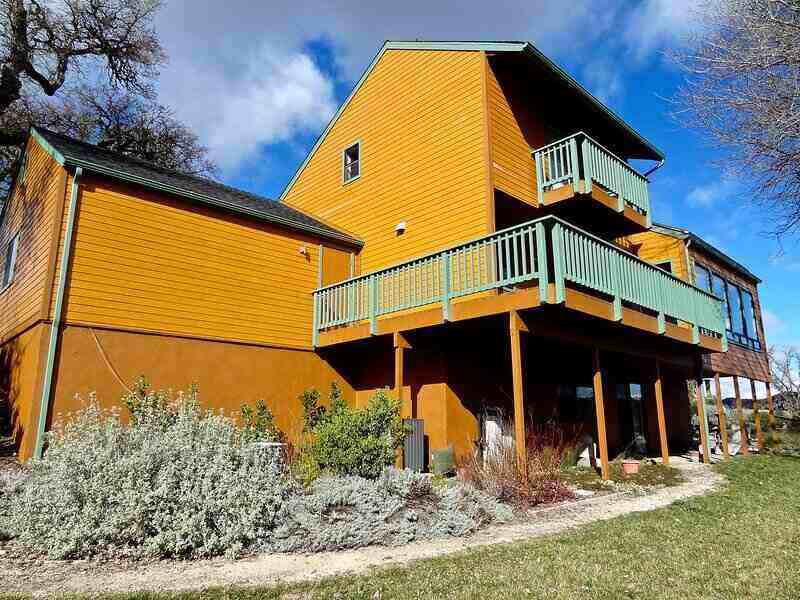
Different siding types all have varying degrees of quality, resulting in different prices. Higher quality siding will typically lead to a higher cost.
Wood siding, for instance, has a wide price range, costing most homeowners between $2.25 to $15.25 per square foot. The price difference is mainly due to the many available wood types and their varying quality. Higher quality wood siding, such as cedar, will cost more than lower quality woods.
Removal
On average, homeowners spend between $1,000 to $2,667 for siding removal. This cost includes removing the siding from your home and disposing of it.
Re-siding
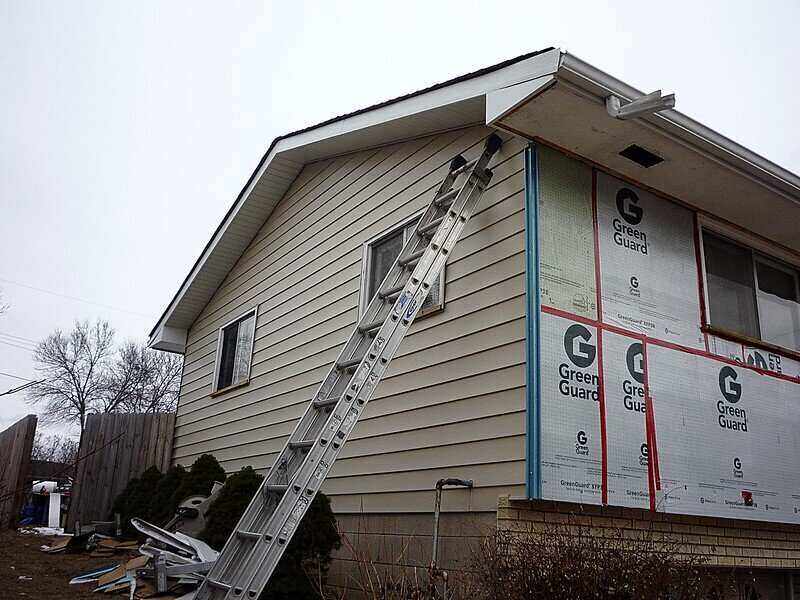
If you’re planning to re-side your home’s exterior, you’ll likely need to remove the old siding. Estimating total re-siding costs isn’t too complicated –– it’s simply the cost of siding removal plus the installation cost.
So: If removal ranges between $1,000 and $2,667 and installation ranges between $5,630 and $17,388, the average homeowner pays between $6,630 and $20,055 to re-side the house.
Repairs
Keeping your siding in good condition helps ensure it will last for years or decades. Repairing siding typically costs between $214 to $1,468, or $630 on average.
Insulated siding
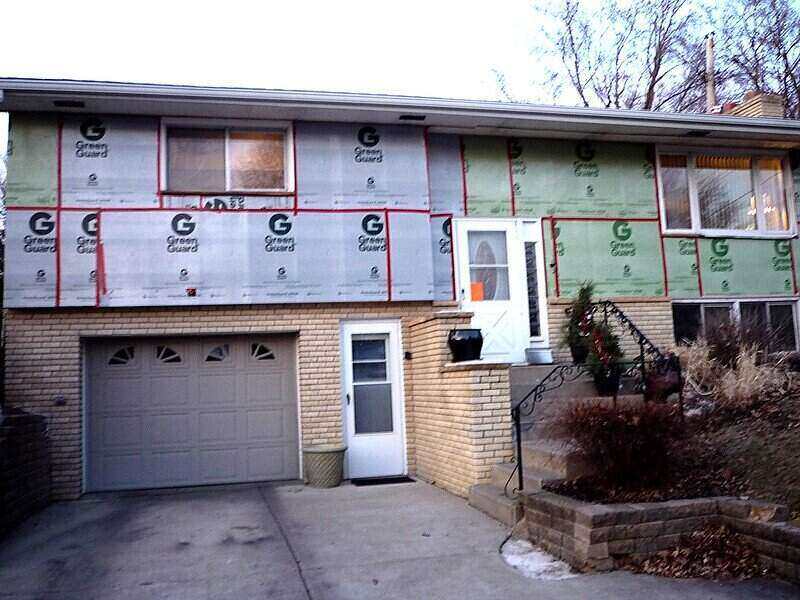
Adding insulation beneath your siding can help reduce your heating and cooling costs, keeping the temperatures inside your home more comfortable. You can add insulation beneath any siding material, but the labor involved will increase your total spending.
To save on costs, you might consider a siding that already has the insulation built-in. Insulated vinyl siding is a popular choice among homeowners, typically costing between $6 to $12.66 per square foot to install.
Extra Services
Siding your home gives your curb appeal an incredible boost, but siding is often just one part of an overall home renovation. Other common home improvement projects often coupled with siding include:
- Seamless Gutters: Replace your old, weathered gutters to help protect your new siding from future moisture problems.
- Painting the House: Not a big fan of your siding’s color? Time for a paint job!
- Window Replacement: If your windows are an eyesore, they’ll distract from your new siding.
- Roof Replacement: If your roof is visibly declining or shingles are falling off, you might need to replace it.
- Landscaping: Your house might not be the only thing that needs updating. You’ll be amazed at what blooming flower beds and charming pathways can do for your curb appeal.
Seamless gutters
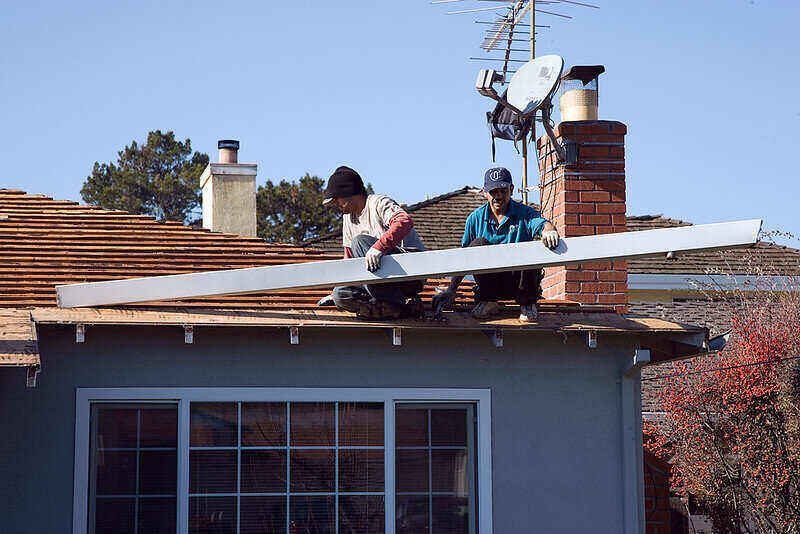
One of the biggest threats to siding is moisture damage. An advantage seamless gutters have over traditional gutters is that they are less susceptible to leaking.
If your traditional gutters are causing moisture problems for your home’s siding, seamless gutters are an excellent alternative. Homeowners typically spend between $1,182 and $2,279 for seamless gutters, or $1,524 on average.
Painting the house
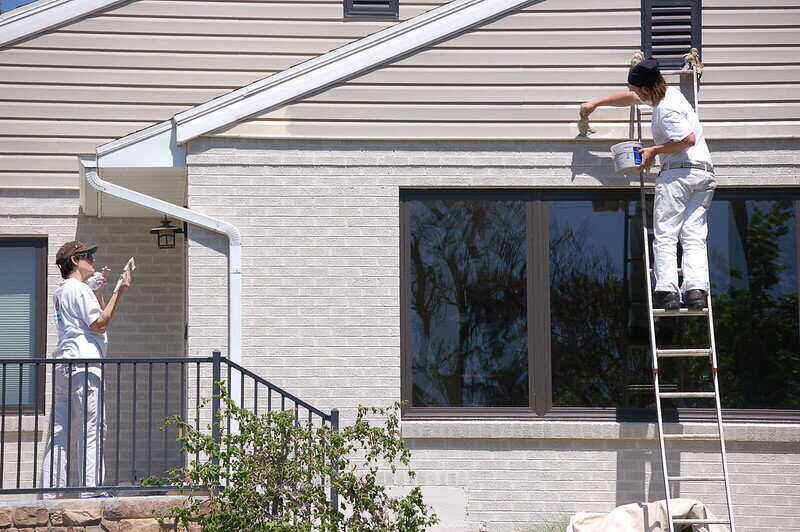
Most siding materials will need a new coat of paint, especially as the color begins to fade. Give your siding a fresh coat of paint with a color you love. Painting a house typically costs between $2,191 and $4,505 or between $1.25 and $4.17 per square foot.
Window replacement
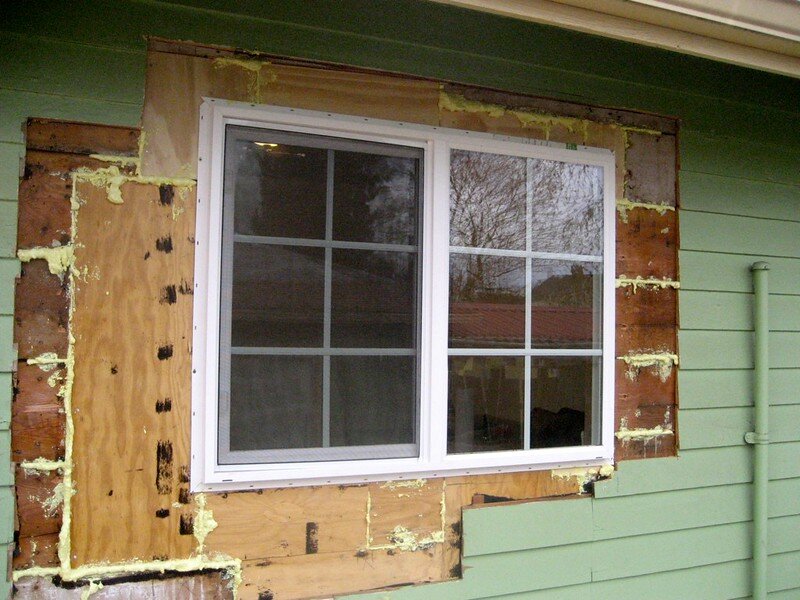
Need to replace a few aging windows? Homeowners can expect to pay between $583 per window or between $300 and $1,400.
Roof replacement
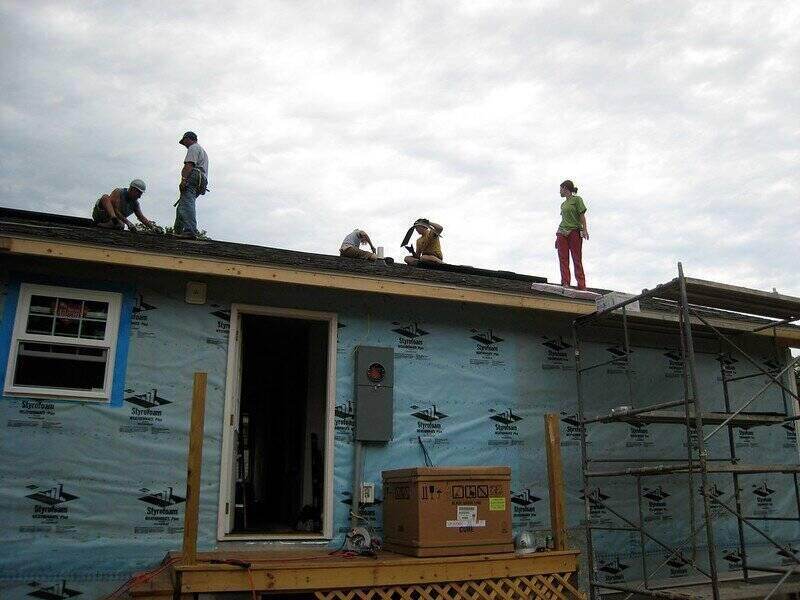
Once your roof starts to leak or is damaged by a severe storm, it’s time for a replacement. Installing a roofing material that harmonizes with your new siding will make your home stand out from the rest.
Expect to pay between $5,119 and $10,675 for a roof replacement. The average cost for roof replacement is $7,766.
Landscaping
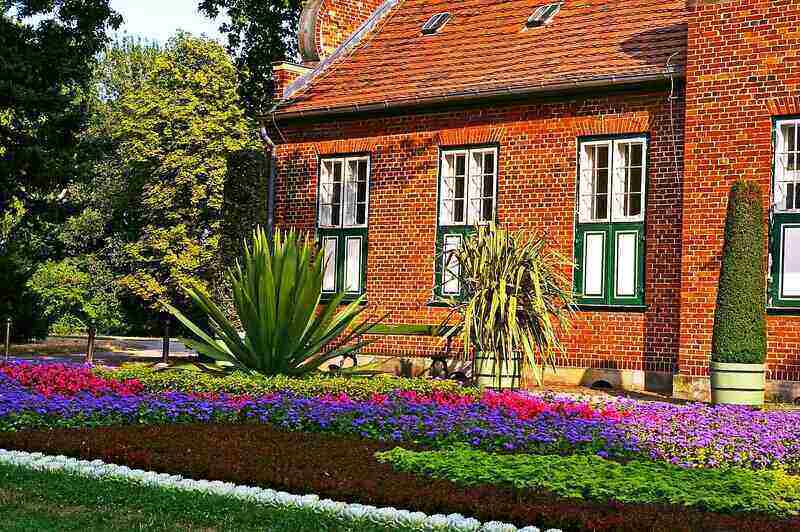
Highlight your home’s new features with an updated landscape. Flower beds can accentuate the color of your new siding, a pergola can enhance your outdoor living area, and paver walkways can direct the eyes to your home’s most attractive features.
Homeowners typically spend between $4,000 and $20,317 to landscape around their home. Your total landscaping cost will vary significantly depending on how much work you need done and what design you’d like.
| LANDSCAPING PROJECT | AVERAGE COST |
| Sod Installation | $0.87 to $1.76 per square foot |
| Pathway Installation | $8 to $22 per square foot |
| Tree and Bush Planting | $25 to $3,000 |
| Flower Bed Planting | $650 to $3,000 |
| Pergola Installation | $2,216 to $8,959 |
| Retaining Wall Installation | $4,025 to $8,711 |
| Gazebo Installation | $5,364 to $9,027 |
| Outdoor Kitchen Installation | $5,057 to $17,276 |
Cost of Siding Across the U.S.
The prices listed in this cost guide are all national averages. On a local scale, the cost of siding materials and labor may vary depending on the region’s demand. Depending on where you live, you might pay below or above the typical price for siding your home.
Cost of DIY Siding Installation
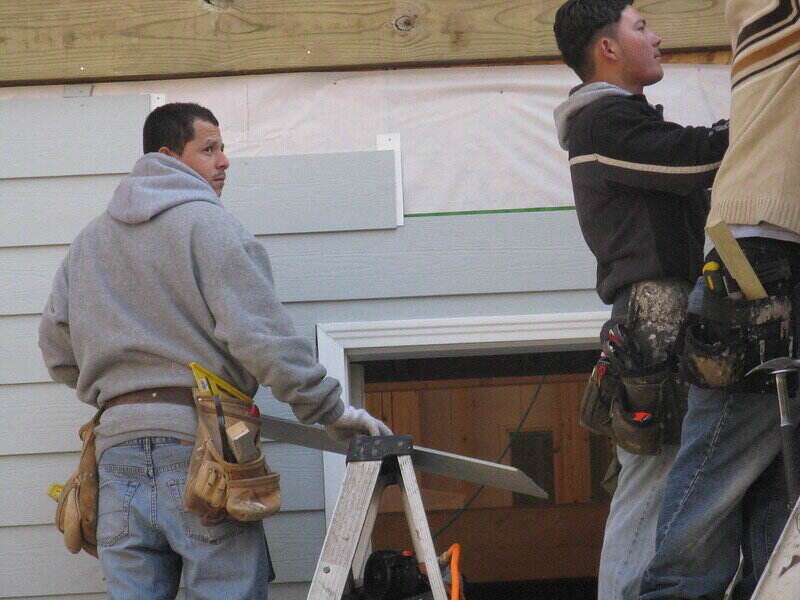
If you’re an experienced DIYer and feel confident in your ability to replace siding yourself, turning it into a DIY project can help save on labor costs. However, if you’re not familiar with advanced home improvement projects, we recommend hiring a professional installer instead.
Some siding materials are more complicated to install than others and better left to the professionals. Fiber cement, for example, requires special equipment to cut and install it. The material is also heavy and highly labor-intensive.
Vinyl siding, on the other hand, is much easier to install. It’s lightweight, requires no initial painting, and is easy to cut. Installing vinyl siding yourself could save you between $1.06 to $2.50 per square foot. If you need to cover 1,000 square feet in vinyl siding, installing it yourself could save you between $1,600 and $2,500.
Keep in mind that installing siding is an extensive process. You’ll need to strip away all original siding before beginning your project. Installing siding on a two-story home only makes the job harder.
Attempting to install the siding yourself may lead to costly mistakes. One wrong step could lead to significant moisture damage, warping, or a lower siding lifespan. As a result, you might incur additional costs on repairs or future replacements.
The bottom line: Installing siding yourself is an advanced DIY project, with vinyl siding being the most DIY-friendly material to install. However, attempting to install siding yourself may lead to costly mistakes. Hiring a professional ensures the best result possible.
For details on how to install vinyl siding yourself, check out this instructional video by Home RenoVision DIY:
FAQ About Siding
When you’re buying siding to install, you need to know how much you need. Otherwise, you risk spending more money on the siding you don’t need or bringing home too little.
Here’s how to estimate how much siding you should purchase:
— Divide your home’s exterior sides into imaginary rectangles, squares, and triangles. Remember to exclude windows, doors, and other areas where you don’t want to side.
— Next, calculate each shape’s area.
— Add all the areas together to get the total square footage.
— Increase the total square footage by 10% to account for any wasted siding, such as mistakes or unusable pieces. The result gives you the total amount of siding you’ll need for your project.
Most manufacturers will sell siding by square footage or by the square. A square contains 100 square feet of siding.
Conclusion
Siding can increase your home’s resale value and boost its aesthetic. There are many house siding options available, including different colors, styles, and materials.
Some siding materials are more advantageous than others, but they sell for a much higher price.
For the best results for your home, turn to a professional for siding installation.
The average cost to side a home is $10,693, with most homeowners paying between $5,630 and $17,388 or between $2.33 and $15.33 per square foot.
Keep in mind that high-end siding projects can cost as much as $90,000 or more. Some low-end projects cost homeowners as little as $2,300. Costs will vary depending on many factors, including your home’s size and the type of siding installed.
Main Photo Credit: Ken Ratcliff / Flickr / CC BY 2.0